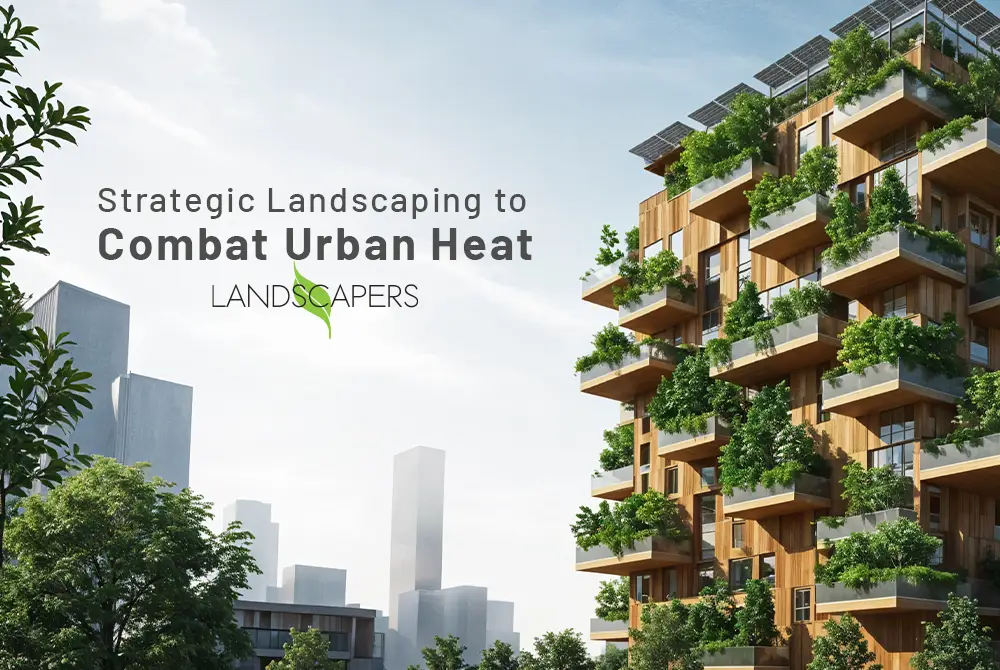
Strategic Landscaping to Combat Urban Heat in Dhaka
Dhaka, the bustling capital of Bangladesh, is one of the world’s most densely populated cities, with over 23.9 million residents in its metropolitan area as of 2024. Rapid urbanisation, coupled with climate change, has intensified the Urban Heat Island (UHI) effect, where the city experiences significantly higher temperatures than surrounding rural areas, sometimes by up to 10°C.
This phenomenon, driven by concrete-heavy infrastructure, dwindling green spaces, and human activity, has made Dhaka increasingly unlivable during heatwaves, with temperatures reaching 40.4°C in April 2023, the hottest in 58 years. Strategic landscaping offers a sustainable solution to mitigate urban heat, improve livability, and enhance resilience in Dhaka. This blog explores tailored landscaping strategies for Dhaka, addressing its unique challenges and opportunities.
Understanding the Urban Heat Island Effect in Dhaka
The UHI effect in Dhaka stems from multiple factors:
- Dense Urbanisation: The city’s landscape is dominated by concrete buildings, asphalt roads, and other heat-absorbing surfaces, with built-up areas increasing by 67% from 1993 to 2020.
- Loss of Green Spaces: Vegetation cover in Dhaka has plummeted, with healthy green spaces dropping from 17% in 1989 to just 2% in 2020, exacerbating heat retention.
- Water Body Reduction: Wetlands, once 20% of Dhaka’s area in 1995, now cover less than 2%, reducing natural cooling through evaporation.
- High Population Density: With approximately 34,000 people per square kilometre, human activities like traffic, industrial processes, and air conditioning further amplify heat.
These factors contribute to UHI intensities ranging from 2.5°C to 7.5°C, increasing energy demands for cooling and posing health risks, particularly for informal workers and residents in poorly ventilated homes. Strategic landscaping, incorporating green and blue infrastructure, can counteract these challenges by leveraging nature-based solutions (NbS).
Strategic Landscaping Solutions for Dhaka
1. Urban Greening and Afforestation
Increasing Tree Cover: Trees act as natural air conditioners, providing shade and cooling through evapotranspiration. Dhaka’s greenery, which has declined by 56% from 1989 to 2020, must be restored through strategic tree planting.
- Roadside and Median Planting: Planting native, heat-tolerant trees like neem (Azadirachta indica) or banyan (Ficus benghalensis) along roads and traffic islands can reduce surface temperatures by 2–3°C.
- Community Involvement: Engaging communities to plant and maintain trees fosters sustainability. Awareness campaigns, as seen in World Environment Day initiatives, encourage residents to participate in greening efforts.
Urban Parks and Green Corridors: Dhaka’s green spaces, such as Ramna Park and the National Botanical Garden, harbour significant biodiversity, including nearly half of Bangladesh’s butterfly species. Expanding parks and creating green corridors along metro lines can enhance cooling and connectivity. Integrating greenways with Dhaka’s Metro Rail system, as proposed in urban planning discussions, could create shaded pathways for pedestrians.
2. Rooftop Gardens and Green Roofs
Rooftop gardens are a practical solution for Dhaka’s high-rise-dominated landscape, where ground space is limited. These gardens reduce building temperatures by up to 7°C, lower energy costs, and improve air quality.
- Implementation: The government’s 10% holding tax exemption for buildings with rooftop gardens has spurred adoption. Residents can grow vegetables, herbs, or ornamental plants in pots or vertical planters, as seen in balcony farming trends.
- Challenges and Solutions: Dhaka’s hot and humid climate requires heat-tolerant plants like amaranth or okra. Integrated pest management (IPM) using natural predators can address pest issues.
- Case Study: Khulna’s training of 25 rooftop gardening experts highlights a scalable model for Dhaka, where similar programs could be expanded through NGOs like FAO or WorldFish.
3. Restoration of Blue Infrastructure
Dhaka, once a city of rivers and canals, has lost significant water bodies due to urban sprawl. Conserving and restoring waterways is critical, as they provide superior cooling compared to green spaces.
- Preserving Wetlands and Ponds: Khulna’s initiative to preserve 23 ponds and lakes can be replicated in Dhaka, where wetlands have dwindled to under 2% of the city’s area.
- Canal Restoration: Revitalising canals like those connected to the Buriganga River can create “blue nodes” for cooling and stormwater management, reducing urban flooding during monsoons.
- Community-Led Conservation: Engaging local communities, as suggested by urban planners, ensures long-term maintenance of water bodies.
4. Cool Roofs and Reflective Surfaces
Cool roofs, coated with reflective materials, reduce heat absorption and lower indoor temperatures. Dhaka’s Cool Roof Initiative has shown promising results, cutting indoor temperatures by over 7°C in informal settlements.
- Implementation: Applying white or reflective coatings to roofs is cost-effective and scalable, particularly for low-income housing.
- Complementary Landscaping: Pairing cool roofs with rooftop gardens enhances insulation and aesthetic appeal, as seen in projects by Baganbari Landscaping Ltd.
5. Sustainable Urban Planning
Dhaka’s unplanned urbanisation exacerbates the UHI effect. Strategic planning can integrate landscaping into city development.
- Mixed Land Use: Encouraging mixed-use developments with green spaces reduces heat exposure and optimises land use.
- Building Design: Orienting buildings for better ventilation and using light-colored materials can minimise heat retention. Real estate companies like Concord are pioneering sustainable designs to combat UHI.
- Policy Support: Dhaka’s first-ever Climate Action Plan (2024) aims for carbon neutrality by 2050, emphasising green cover and sustainable practices. Incorporating NbS into urban planning aligns with Bangladesh’s National Adaptation Plan.
Challenges in Implementing Strategic Landscaping in Dhaka
- Limited Space: Dhaka’s high density (34,000 people/km²) restricts available land for greening. Rooftop and vertical gardening offer viable alternatives.
- Policy Gaps: Urban agriculture and greening are often absent from mainstream planning. Stronger policy frameworks, as suggested by IUCN, are needed to support NbS.
- Resource Constraints: Water scarcity and lack of technical knowledge hinder rooftop gardening. Training programs and subsidies can address these barriers.
- Institutional Conflicts: Weak coordination among departments has slowed green space initiatives. Strategic environmental assessments and stakeholder collaboration can resolve these issues.
Opportunities and Recommendations
- Leverage Existing Initiatives: Scale up successful models like Khulna’s pond preservation and rooftop gardening training.
- Incentivise Greening: Expand tax exemptions and provide subsidies for green roofs and tree planting to encourage private participation.
- Community Engagement: Involve residents in greening projects through awareness campaigns and training, as seen in community-led tree planting.
- Integrate with Infrastructure: Combine green corridors with metro expansions and restore canals to create a network of cooling zones.
- Policy Integration: Embed NbS in Dhaka’s Climate Action Plan and urban planning frameworks to ensure long-term commitment.
Conclusion
Strategic landscaping offers a lifeline for Dhaka to combat the escalating Urban Heat Island effect. By prioritising urban greening, restoring waterways, adopting cool roofs, and integrating sustainable planning, Dhaka can reduce temperatures, enhance livability, and build resilience against climate change. With only 16.17% vegetation cover in Dhaka North City Corporation, and wetlands nearly vanished, urgent action is needed. Collaborative efforts among policymakers, urban planners, real estate developers, and communities can transform Dhaka into a cooler, greener, and more sustainable megacity. As the city grows, balancing urbanisation with nature-based solutions will ensure a resilient future for its 23.9 million residents.

